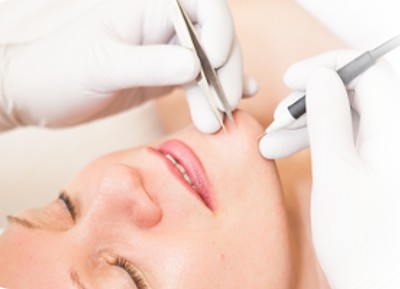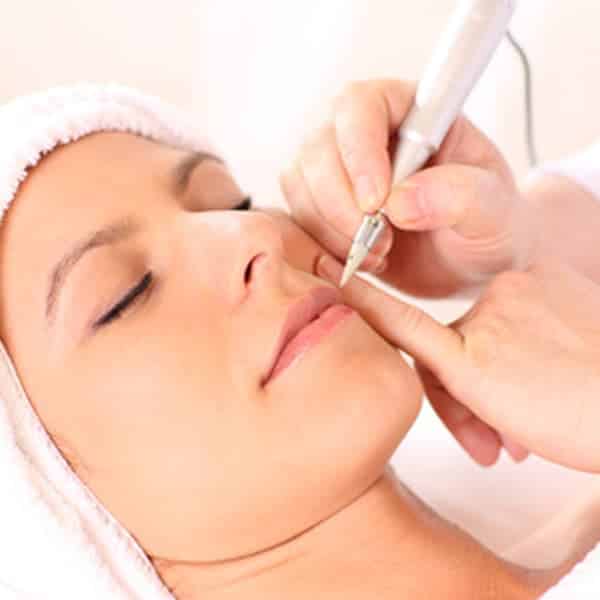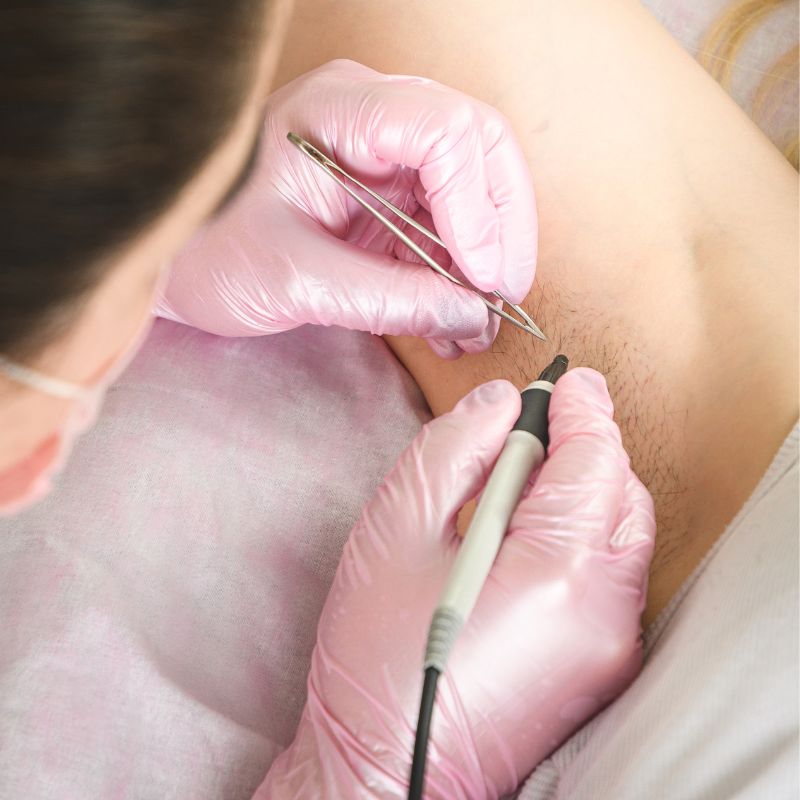Electrolysis Treatment In Action

Electrolysis has become a widely available treatment in many beauty salons for the permanent removal of unwanted hair for both men and women.
Electrolysis is the removal of unwanted hair through the means of a probe or needle inserted into the hair follicle. There are three different methods available on the market, Galvanic electrolysis, Thermolysis/Diathermy/Short Wave Electrolysis and Blend Electrolysis.
The aim of all the methods is to damage the base of the growing hair in order to cut off the blood supply and nutrition to the hair, preventing any new growth from developing. The technique is selective and minimal damage should occur to surrounding tissues. Electrolysis, in experienced hands, can also be used to improve the appearance of thread veins.
Currently, needle-type electrolysis is the only method which can guarantee permanent hair removal and can be used on all areas of the body and for all skin types. Lasers and other light sources, although widely advertised as a method for hair removal, are still only legally permitted to claim a permanent reduction in hair growth, not permanent removal.
The aim of all the methods is to damage the base of the growing hair in order to cut off the blood supply and nutrition to the hair, preventing any new growth from developing. The technique is selective and minimal damage should occur to surrounding tissues. Treatment sessions can last from 30 minutes to over 2 hours depending upon the area treated, and your tolerance to the discomfort of the treatment.
All hairs have differing cycles of growth and are not all visible on the surface of the skin at the same time. Also, hair removed using electrolysis may not necessarily destroy the hair follicles' capability of producing new hair. Therefore, it is necessary to have some repeat treatments and your practitioner will calculate how often you need them based on the area treated, the technique he or she has used, and how hairy you normally are!
Electrolysis is the removal of unwanted hair through the means of a probe or needle inserted into the hair follicle. There are three different methods available on the market, Galvanic electrolysis, Thermolysis/Diathermy/Short Wave Electrolysis and Blend Electrolysis.
The aim of all the methods is to damage the base of the growing hair in order to cut off the blood supply and nutrition to the hair, preventing any new growth from developing. The technique is selective and minimal damage should occur to surrounding tissues. Electrolysis, in experienced hands, can also be used to improve the appearance of thread veins.
Currently, needle-type electrolysis is the only method which can guarantee permanent hair removal and can be used on all areas of the body and for all skin types. Lasers and other light sources, although widely advertised as a method for hair removal, are still only legally permitted to claim a permanent reduction in hair growth, not permanent removal.
The aim of all the methods is to damage the base of the growing hair in order to cut off the blood supply and nutrition to the hair, preventing any new growth from developing. The technique is selective and minimal damage should occur to surrounding tissues. Treatment sessions can last from 30 minutes to over 2 hours depending upon the area treated, and your tolerance to the discomfort of the treatment.
All hairs have differing cycles of growth and are not all visible on the surface of the skin at the same time. Also, hair removed using electrolysis may not necessarily destroy the hair follicles' capability of producing new hair. Therefore, it is necessary to have some repeat treatments and your practitioner will calculate how often you need them based on the area treated, the technique he or she has used, and how hairy you normally are!


Electrolysis is generally considered the most painful method of hair removal available, but the advantage of it is that it is the most effective and long-lasting treatment you can have.
Patients variously describe the sensation of electrolysis as being like a "bee-sting€, a "twinge" or a "zap". Most people find along the lip line and under the nostrils to be especially sensitive. With electrolysis, you must work as close to your pain threshold as possible for the most effective treatment. If your settings are too low, treatment will be ineffective. This means that you'll have to have more sessions and thus more pain! The best advice is to grit your teeth and just let the practitioner get on with it. It will hurt, but the pain won't last for too long!
It is very important that you follow the advice of your practitioner carefully after electrolysis for hair removal to reduce the risk of complications.
Post-treatment advice may include:
Patients variously describe the sensation of electrolysis as being like a "bee-sting€, a "twinge" or a "zap". Most people find along the lip line and under the nostrils to be especially sensitive. With electrolysis, you must work as close to your pain threshold as possible for the most effective treatment. If your settings are too low, treatment will be ineffective. This means that you'll have to have more sessions and thus more pain! The best advice is to grit your teeth and just let the practitioner get on with it. It will hurt, but the pain won't last for too long!
It is very important that you follow the advice of your practitioner carefully after electrolysis for hair removal to reduce the risk of complications.
Post-treatment advice may include:
- Applying an antiseptic cream after treatment
- Not exposing yourself to the sun without applying a high factor sunblock to the treated area
THE AMOUNT OF TREATMENT TIME THAT MAY BE REQUIRED FOR DIFFERENT AREAS IS EXTREMELY VARIABLE,BUT COULD BE:
Upper Lip: 4 – 10 hours
Chin: 2 – 12 hours
Underarms: 4 – 12 hours
Arms: 5 – 10 hours
Bikini Line: 8 – 16 hours
No recovery time is necessary. You can return to work and normal activities immediately after a treatment.
As long as you are generally healthy and don't have any skin diseases or infections in the area treated, there are few medical reasons why patients should not undergo this treatment.
Although there is no evidence that this treatment is harmful for pregnant women, you may be advised to wait until after you have given birth before embarking upon a course of treatment.
Electrolysis is a useful technique for treating small areas quickly and efficiently, giving good and usually permanent results. Both men and women can use it.
These results are best for fine hair that has not previously been plucked or waxed. Deep, coarse hairs cannot always be removed with one treatment; thus, breaking down these hair germ cells may require further treatments. This can be a particular concern for some male patients.
For larger areas, such as legs or back, the pain associated with this treatment and the time taken makes it a less suitable treatment option than for smaller parts of the body.
Electrolysis is also sometimes used by experienced electrologists for the treatment of thread veins and skin tags.
Although there is no evidence that this treatment is harmful for pregnant women, you may be advised to wait until after you have given birth before embarking upon a course of treatment.
Electrolysis is a useful technique for treating small areas quickly and efficiently, giving good and usually permanent results. Both men and women can use it.
These results are best for fine hair that has not previously been plucked or waxed. Deep, coarse hairs cannot always be removed with one treatment; thus, breaking down these hair germ cells may require further treatments. This can be a particular concern for some male patients.
For larger areas, such as legs or back, the pain associated with this treatment and the time taken makes it a less suitable treatment option than for smaller parts of the body.
Electrolysis is also sometimes used by experienced electrologists for the treatment of thread veins and skin tags.
